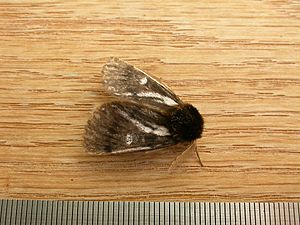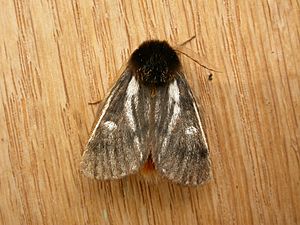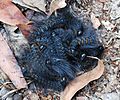Bag-shelter moth facts for kids
Quick facts for kids Bag-shelter moth |
|
|---|---|
 |
|
 |
|
| Scientific classification | |
| Kingdom: | |
| Phylum: | |
| Class: | |
| Order: | |
| Family: |
Notodontidae
|
| Subfamily: |
Thaumetopoeinae
|
| Genus: |
Ochrogaster
|
| Species: |
O. lunifer
|
| Binomial name | |
| Ochrogaster lunifer Herrich-Schäffer, 1855
|
|
The bag-shelter moth, also called the processionary caterpillar, is a cool insect from the moth family Notodontidae. Its scientific name is Ochrogaster lunifer. This species was first named by Gottlieb August Wilhelm Herrich-Schäffer in 1855. Both the caterpillars and the adult moths have tiny hairs that can make your skin itchy if you touch them. The adult moth looks fluffy and its wings can spread about 5.5 centimeters wide. The caterpillars eat the leaves of Grevillea striata at night. During the day, they hide in a brown silk nest.
Contents
Life and Habits of the Bag-Shelter Moth
Their Special Nests
During the day, these caterpillars all gather together inside a special nest. This nest is made of silk, their droppings, old skin they've shed, and other bits of stuff. Sometimes, you can find these nests on a branch, high up on a tree trunk, or even on the ground near their food plant. Because their nesting habits can be different, scientists think there might be more than one type of Ochrogaster moth.
What They Eat and How They Travel
These caterpillars mostly eat acacia trees, also known as wattle trees, and Grevillea striata trees. If they eat all the leaves on one tree, they need to find another. When they move, they leave a silk trail behind them. If another caterpillar finds this trail, it will follow it, especially if there's a special chemical scent, called a pheromone, with it.
Amazing Processions
You can often see a hundred or more caterpillars walking in a long line, head-to-tail. They stay together by touching the tail hairs of the caterpillar in front. If something bothers them, they quickly curl up into a tight ball to protect themselves.
Sometimes, if two caterpillars each find a silk trail left by the other, they might end up following each other in a circle! If a whole group does this, they can get stuck walking around in a big circle.
Growing Up and Changing
When the caterpillars are ready to change into moths, they leave their food plant. They walk away, still leaving a silk trail, to find a good spot to pupate. This means they will turn into a pupa, which is like a cocoon. The pupa is hidden in a silk cocoon underground.
Later, the adult moths come out of the pupa. Their wings can spread up to 5.5 centimeters. The front wings are usually dark grey or brown. The back wings are white, turning grey near the body. Some moths have a light dot on each front wing, while others have white lines across their wings. They have a striped body that ends in a white tuft of hairs. The different markings on the moths also make scientists think there might be more than one species in Australia.
Where They Live
You can find the bag-shelter moth all over mainland Australia.
Why Their Hairs Are Special
The caterpillar larvae have tiny, fine spines all over them. These spines contain a special chemical that can cause skin irritation. This is their main way to protect themselves from danger.
Gallery







